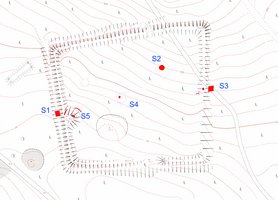Altheim-Heiligkreuztal "Speckhau" - Cult Site or Late Celtic Farmstead?
About 1.8km west of the Heuneburg, 70m east of the Late Hallstatt large burial mound Hohmichele, which is located within the "Speckhau necropolis", lies a rampart-ditch area of about 1 hectare. For a long time existed the question of how to interpret this site. Was it connected with the tumulus? Did it function as a burial ground or cult complex? Or was it one of the Late Celtic quadrangular enclosures known in many places?


On the basis of geomagnetic measurements, five excavation sections were made (S1-S5). Sections S1 and S3 served to investigate the rampart-ditch defence. In section 1, a circular ditch for the enclosure of a burial mound was partially documented, having since been covered by a rampart. Subsequently, the centre of the mound was uncovered in section 5. A burial pit with a heavily corroded iron spearhead and a bronze Hallstatt period drum brooch were also uncovered. No bones were preserved. In section 2, a well was uncovered in 2014 and 2015 to a total depth of 2.45m. In the last section it had retained a diameter of approx. 2.6m. Drillings have shown that the well extends a further 5.5 to 6 m in depth. The backfill from the well yielded numerous finds from the late La Tène period. In section 4, the remains of a collapsed oval dome furnace were also unearthed, which, according to radiocarbon dating, can also be assigned to this Late Celtic period. The features, in the form of a well, a kiln and several settlement pits inside the site, as well as the find material, prove that a Late La Tène square enclosure was built in the area of an older Hallstatt burial ground. An older burial mound was integrated into the rampart of the enclosure. The location near an older tumulus field suggests that ancestor veneration may have played a role in the choice of site during the Late La Tène period.
Lit: Hansen u. a. 2014a; Hansen/Krausse/Tarpini 2018a.


